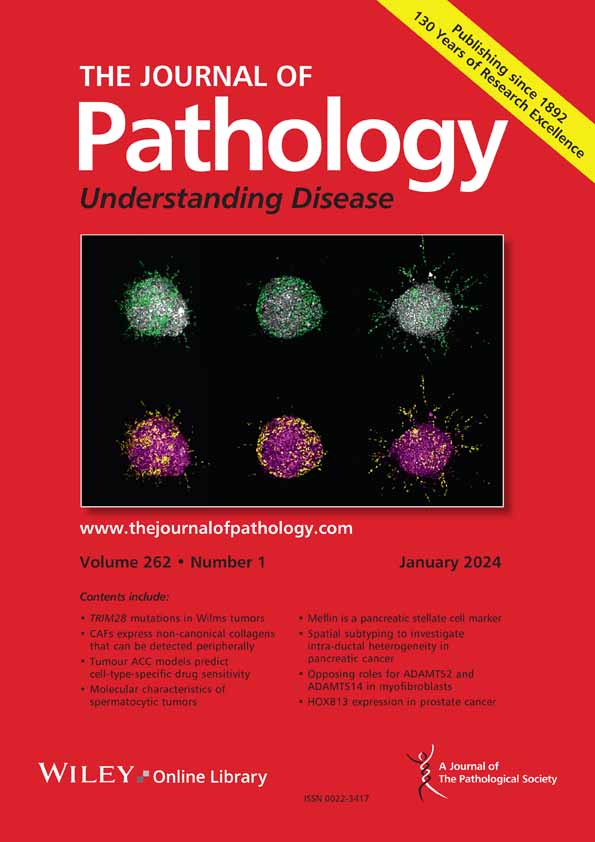求助PDF
{"title":"单细胞分析确定了子宫内膜异位症构成细胞的不同激素、免疫和炎症特征","authors":"Sun Shin, Youn-Jee Chung, Seong Won Moon, Eun Ji Choi, Mee-Ran Kim, Yeun-Jun Chung, Sug Hyung Lee","doi":"10.1002/path.6178","DOIUrl":null,"url":null,"abstract":"<p>Endometriosis consists of ectopic endometrial epithelial cells (EEECs) and ectopic endometrial stromal cells (EESCs) mixed with heterogeneous stromal cells. To address how endometriosis-constituting cells are different from normal endometrium and among endometriosis subtypes and how their molecular signatures are related to phenotypic manifestations, we analyzed ovarian endometrial cyst (OEC), superficial peritoneal endometriosis (SPE), and deep infiltrating endometriosis (DIE) from 12 patients using single-cell RNA-sequencing (scRNA-seq). We identified 11 cell clusters, including EEEC, EESC, fibroblasts, inflammatory/immune, endothelial, mesothelial, and Schwann cells. For hormonal signatures, EESCs, but not EEECs, showed high estrogen signatures (estrogen response scores and <i>HOXA</i> downregulation) and low progesterone signatures (<i>DKK1</i> downregulation) compared to normal endometrium. In EEECs, we found <i>MUC5B</i><sup>+</sup> <i>TFF3</i><sup><i>low</i></sup> cells enriched in endometriosis. In lymphoid cells, evidence for both immune activation (high cytotoxicity in NK) and exhaustion (high checkpoint genes in NKT and cytotoxic T) was identified in endometriosis. Signatures and subpopulations of macrophages were remarkably different among endometriosis subtypes with increased monocyte-derived macrophages and <i>IL1B</i> expression in DIE. The scRNA-seq predicted <i>NRG1</i> (macrophage)-<i>ERBB3</i> (Schwann cell) interaction in endometriosis, expressions of which were validated by immunohistochemistry. Myofibroblast subpopulations differed according to the location (OECs from fibroblasts and SPE/DIEs from mesothelial cells and fibroblasts). Endometriosis endothelial cells displayed proinflammation, angiogenesis, and leaky permeability signatures that were enhanced in DIE. Collectively, our study revealed that (1) many cell types—endometrial, lymphoid, macrophage, fibroblast, and endothelial cells—are altered in endometriosis; (2) endometriosis cells show estrogen responsiveness, immunologic cytotoxicity and exhaustion, and proinflammation signatures that are different in endometriosis subtypes; and (3) novel endometriosis-specific findings of <i>MUC5B</i><sup><i>+</i></sup> EEECs, mesothelial cell-derived myofibroblasts, and <i>NRG1-ERBB3</i> interaction may underlie the pathogenesis of endometriosis. Our results may help extend pathologic insights, dissect aggressive diseases, and discover therapeutic targets in endometriosis. © 2023 The Pathological Society of Great Britain and Ireland.</p>","PeriodicalId":232,"journal":{"name":"The Journal of Pathology","volume":"261 3","pages":"323-334"},"PeriodicalIF":5.6000,"publicationDate":"2023-09-08","publicationTypes":"Journal Article","fieldsOfStudy":null,"isOpenAccess":false,"openAccessPdf":"","citationCount":"0","resultStr":"{\"title\":\"Single-cell profiling identifies distinct hormonal, immunologic, and inflammatory signatures of endometriosis-constituting cells\",\"authors\":\"Sun Shin, Youn-Jee Chung, Seong Won Moon, Eun Ji Choi, Mee-Ran Kim, Yeun-Jun Chung, Sug Hyung Lee\",\"doi\":\"10.1002/path.6178\",\"DOIUrl\":null,\"url\":null,\"abstract\":\"<p>Endometriosis consists of ectopic endometrial epithelial cells (EEECs) and ectopic endometrial stromal cells (EESCs) mixed with heterogeneous stromal cells. To address how endometriosis-constituting cells are different from normal endometrium and among endometriosis subtypes and how their molecular signatures are related to phenotypic manifestations, we analyzed ovarian endometrial cyst (OEC), superficial peritoneal endometriosis (SPE), and deep infiltrating endometriosis (DIE) from 12 patients using single-cell RNA-sequencing (scRNA-seq). We identified 11 cell clusters, including EEEC, EESC, fibroblasts, inflammatory/immune, endothelial, mesothelial, and Schwann cells. For hormonal signatures, EESCs, but not EEECs, showed high estrogen signatures (estrogen response scores and <i>HOXA</i> downregulation) and low progesterone signatures (<i>DKK1</i> downregulation) compared to normal endometrium. In EEECs, we found <i>MUC5B</i><sup>+</sup> <i>TFF3</i><sup><i>low</i></sup> cells enriched in endometriosis. In lymphoid cells, evidence for both immune activation (high cytotoxicity in NK) and exhaustion (high checkpoint genes in NKT and cytotoxic T) was identified in endometriosis. Signatures and subpopulations of macrophages were remarkably different among endometriosis subtypes with increased monocyte-derived macrophages and <i>IL1B</i> expression in DIE. The scRNA-seq predicted <i>NRG1</i> (macrophage)-<i>ERBB3</i> (Schwann cell) interaction in endometriosis, expressions of which were validated by immunohistochemistry. Myofibroblast subpopulations differed according to the location (OECs from fibroblasts and SPE/DIEs from mesothelial cells and fibroblasts). Endometriosis endothelial cells displayed proinflammation, angiogenesis, and leaky permeability signatures that were enhanced in DIE. Collectively, our study revealed that (1) many cell types—endometrial, lymphoid, macrophage, fibroblast, and endothelial cells—are altered in endometriosis; (2) endometriosis cells show estrogen responsiveness, immunologic cytotoxicity and exhaustion, and proinflammation signatures that are different in endometriosis subtypes; and (3) novel endometriosis-specific findings of <i>MUC5B</i><sup><i>+</i></sup> EEECs, mesothelial cell-derived myofibroblasts, and <i>NRG1-ERBB3</i> interaction may underlie the pathogenesis of endometriosis. Our results may help extend pathologic insights, dissect aggressive diseases, and discover therapeutic targets in endometriosis. © 2023 The Pathological Society of Great Britain and Ireland.</p>\",\"PeriodicalId\":232,\"journal\":{\"name\":\"The Journal of Pathology\",\"volume\":\"261 3\",\"pages\":\"323-334\"},\"PeriodicalIF\":5.6000,\"publicationDate\":\"2023-09-08\",\"publicationTypes\":\"Journal Article\",\"fieldsOfStudy\":null,\"isOpenAccess\":false,\"openAccessPdf\":\"\",\"citationCount\":\"0\",\"resultStr\":null,\"platform\":\"Semanticscholar\",\"paperid\":null,\"PeriodicalName\":\"The Journal of Pathology\",\"FirstCategoryId\":\"3\",\"ListUrlMain\":\"https://onlinelibrary.wiley.com/doi/10.1002/path.6178\",\"RegionNum\":2,\"RegionCategory\":\"医学\",\"ArticlePicture\":[],\"TitleCN\":null,\"AbstractTextCN\":null,\"PMCID\":null,\"EPubDate\":\"\",\"PubModel\":\"\",\"JCR\":\"Q1\",\"JCRName\":\"ONCOLOGY\",\"Score\":null,\"Total\":0}","platform":"Semanticscholar","paperid":null,"PeriodicalName":"The Journal of Pathology","FirstCategoryId":"3","ListUrlMain":"https://onlinelibrary.wiley.com/doi/10.1002/path.6178","RegionNum":2,"RegionCategory":"医学","ArticlePicture":[],"TitleCN":null,"AbstractTextCN":null,"PMCID":null,"EPubDate":"","PubModel":"","JCR":"Q1","JCRName":"ONCOLOGY","Score":null,"Total":0}
引用次数: 0
引用
批量引用


